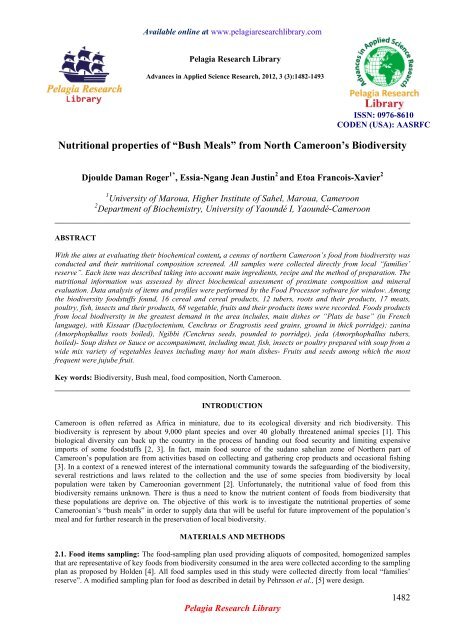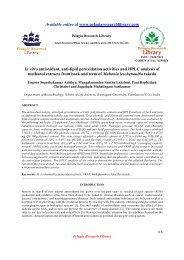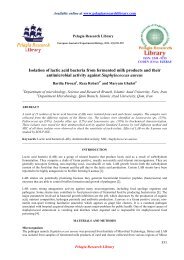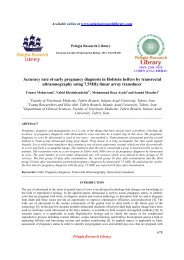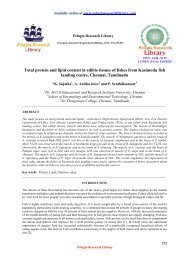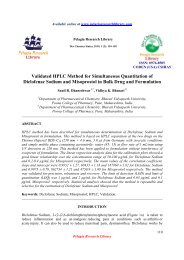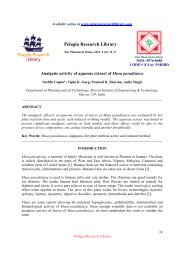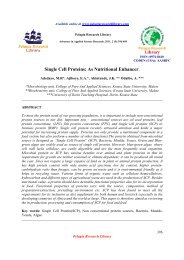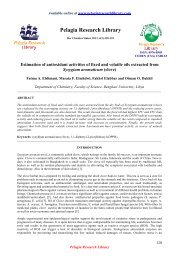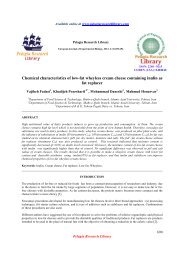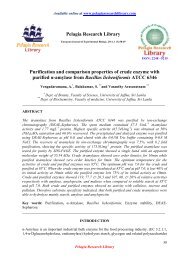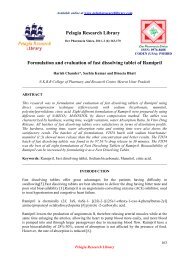Nutritional properties of “Bush Meals” - Pelagia Research Library
Nutritional properties of “Bush Meals” - Pelagia Research Library
Nutritional properties of “Bush Meals” - Pelagia Research Library
Create successful ePaper yourself
Turn your PDF publications into a flip-book with our unique Google optimized e-Paper software.
Available online at www.pelagiaresearchlibrary.com<br />
<strong>Pelagia</strong> <strong>Research</strong> <strong>Library</strong><br />
Advances in Applied Science <strong>Research</strong>, 2012, 3 (3):1482-1493<br />
ISSN: 0976-8610<br />
CODEN (USA): AASRFC<br />
<strong>Nutritional</strong> <strong>properties</strong> <strong>of</strong> <strong>“Bush</strong> <strong>Meals”</strong> from North Cameroon’s Biodiversity<br />
Djoulde Daman Roger 1* , Essia-Ngang Jean Justin 2 and Etoa Francois-Xavier 2<br />
1 University <strong>of</strong> Maroua, Higher Institute <strong>of</strong> Sahel, Maroua, Cameroon<br />
2 Department <strong>of</strong> Biochemistry, University <strong>of</strong> Yaoundé I, Yaoundé-Cameroon<br />
______________________________________________________________________________<br />
ABSTRACT<br />
With the aims at evaluating their biochemical content, a census <strong>of</strong> northern Cameroon’s food from biodiversity was<br />
conducted and their nutritional composition screened. All samples were collected directly from local “families’<br />
reserve”. Each item was described taking into account main ingredients, recipe and the method <strong>of</strong> preparation. The<br />
nutritional information was assessed by direct biochemical assessment <strong>of</strong> proximate composition and mineral<br />
evaluation. Data analysis <strong>of</strong> items and pr<strong>of</strong>iles were performed by the Food Processor s<strong>of</strong>tware for window. Among<br />
the biodiversity foodstuffs found, 16 cereal and cereal products, 12 tubers, roots and their products, 17 meats,<br />
poultry, fish, insects and their products, 68 vegetable, fruits and their products items were recorded. Foods products<br />
from local biodiversity in the greatest demand in the area includes, main dishes or “Plats de base” (in French<br />
language), with Kissaar (Dactyloctenium, Cenchrus or Eragrostis seed grains, ground in thick porridge); zanina<br />
(Amorphophallus roots boiled), Ngibbi (Cenchrus seeds, pounded to porridge), jeda (Amorphophallus tubers,<br />
boiled)- Soup dishes or Sauce or accompaniment, including meat, fish, insects or poultry prepared with soup from a<br />
wide mix variety <strong>of</strong> vegetables leaves including many hot main dishes- Fruits and seeds among which the most<br />
frequent were jujube fruit.<br />
Key words: Biodiversity, Bush meal, food composition, North Cameroon.<br />
______________________________________________________________________________<br />
INTRODUCTION<br />
Cameroon is <strong>of</strong>ten referred as Africa in miniature, due to its ecological diversity and rich biodiversity. This<br />
biodiversity is represent by about 9,000 plant species and over 40 globally threatened animal species [1]. This<br />
biological diversity can back up the country in the process <strong>of</strong> handing out food security and limiting expensive<br />
imports <strong>of</strong> some foodstuffs [2, 3]. In fact, main food source <strong>of</strong> the sudano sahelian zone <strong>of</strong> Northern part <strong>of</strong><br />
Cameroon’s population are from activities based on collecting and gathering crop products and occasional fishing<br />
[3]. In a context <strong>of</strong> a renewed interest <strong>of</strong> the international community towards the safeguarding <strong>of</strong> the biodiversity,<br />
several restrictions and laws related to the collection and the use <strong>of</strong> some species from biodiversity by local<br />
population were taken by Cameroonian government [2]. Unfortunately, the nutritional value <strong>of</strong> food from this<br />
biodiversity remains unknown. There is thus a need to know the nutrient content <strong>of</strong> foods from biodiversity that<br />
these populations are deprive on. The objective <strong>of</strong> this work is to investigate the nutritional <strong>properties</strong> <strong>of</strong> some<br />
Cameroonian’s “bush meals” in order to supply data that will be useful for future improvement <strong>of</strong> the population’s<br />
meal and for further research in the preservation <strong>of</strong> local biodiversity.<br />
MATERIALS AND METHODS<br />
2.1. Food items sampling: The food-sampling plan used providing aliquots <strong>of</strong> composited, homogenized samples<br />
that are representative <strong>of</strong> key foods from biodiversity consumed in the area were collected according to the sampling<br />
plan as proposed by Holden [4]. All food samples used in this study were collected directly from local “families’<br />
reserve”. A modified sampling plan for food as described in detail by Pehrsson et al., [5] were design.<br />
<strong>Pelagia</strong> <strong>Research</strong> <strong>Library</strong><br />
1482
Djoulde Daman Roger et al Adv. Appl. Sci. Res., 2012, 3(3):1482-1493<br />
_____________________________________________________________________________<br />
2.2. Food description and nutrient content <strong>of</strong> foods items and dishes assessment: Each item and dishes were<br />
described taking into account main ingredients, recipe and the method <strong>of</strong> preparation <strong>of</strong> “bush meals”. Their<br />
nutritional information was assessed by direct biochemical analysis as describe below.<br />
2.3. Proximate composition: AOAC methods [6] were used: drying at 105°C for moisture (method 925.098);<br />
incineration at 550°C for ash (method 923.03); defeating in a soxhlet apparatus with 2:1 chlor<strong>of</strong>orm/methanol, for<br />
total fats (method 920.39C with minor modifications); and micro Kjeldahl for protein (Nx6.25) (method 960.52).<br />
Total carbohydrates were estimated by difference.<br />
2.4. Mineral evaluation: Ca, Cu, Fe, Mg, Mn, Zn were determined by AAS method as describe by AACC [7], after<br />
mineralisation <strong>of</strong> all samples.<br />
2.5. Data analysis: The analysis <strong>of</strong> items and pr<strong>of</strong>iles were performed by inserting collected data from SFFQ, and<br />
direct biochemical analysis data in the Food Processor s<strong>of</strong>tware for window Version 8.1 and further analysis was<br />
completed by using excel 2007, and Splus 2000 for window 2001.<br />
RESULTS AND DISCUSSION<br />
3.1. Food description: Tables 1, 2, 3 and 4 give an overview <strong>of</strong> recorded item and dishes divided in Cereals and<br />
their products with 16 items (Table 1), tubers, roots and their products (Table 2) with 12 items, the group <strong>of</strong> meats,<br />
poultry, fish, insects and their products (Table 3) with 17 items, and finally the group <strong>of</strong> vegetable, fruits and their<br />
products (Table 4) with 68 items. We may notice that comparing to the latest compile Cameroon’s foods from<br />
biodiversity [8,9], we record 52% <strong>of</strong> cereal and cereal products, 15% <strong>of</strong> tubers, roots and their products 45% meats,<br />
poultry, fish, insects and their products, 72% vegetable, fruits and their products are coming from northern part <strong>of</strong><br />
the country. In fact populations are able to choose from following wide variety <strong>of</strong> outlets providing traditional “bush<br />
meals”:<br />
- Main dishes or “Plats de base”: sorghum, rice or maize meal hard porridge flavored with Brachiaria Setaria or<br />
Dactyloctenium, Kissaar (Dactyloctenium, Cenchrus or Eragrostis seed grains, ground in thick porridge); zanina<br />
(Amorphophallus roots boiled). Ngibbi (Cenchrus seeds, pounded to porridge), jeda (Amorphophallus tubers,<br />
boiled). We also notice that “bush meals” are not named according to the main food item source, but according to<br />
the form <strong>of</strong> food. For example gabruna or mu is designed for Cochlospermu or Anchomanes or Stylochiton tuber<br />
boiled without any differentiation <strong>of</strong> the tuber specie. When the same items are boiled or cooked and then pounded<br />
it’s named gabura or ma.<br />
- Soup dishes or Sauce or accompaniment: These are mainly dishes including meat, fish or poultry prepared with<br />
soup from a wide mix variety <strong>of</strong> vegetables leaves and including many hot main course dishes with proteins and fat<br />
from mammal meat, insects and vegetables as well. A selection <strong>of</strong> many different vegetables and legumes; a<br />
selection <strong>of</strong> fresh fruits; dry fruits and vegetables, from wildlife source are available (Tables 2, 3, 4 and 5)<br />
- Fruits and seeds (approximately half <strong>of</strong> the collected species) among which some can be regarded as semi<br />
domesticated are also available from wildlife: Among most frequent we have jujube fruit (Zizyphus jujuba), tamarin<br />
fruit (Tamarindus indica), figues fruits (Ficus sycomorus, Ficus platyphilla), the date palm <strong>of</strong> the desert (Balanites<br />
aegyptiaca), from which Muzey draw almond an edible oil [10] palm trees: doum (Hyphaene thebaica), which is<br />
mainly use in case <strong>of</strong> food shortage [10], and the ronier (Borassus flabellifer), whose fruits walls and germ are also<br />
use as food [11]. Other fruits sources from biodiversity recorded from North Cameroonian diet are Sclerocarya<br />
birrea, Strychnos innocua, Celtis integrifolia, Vitex doniana, Diospyros mespiliformis, Capparis afzelii, Anogeissus<br />
leiocarpus, Detarium senegalensis, Parinaria curatellifolia, Annona senegalensis (sore), Vitellaria paradoxa<br />
(karite), Parkia biglobosa (néré); Cassia occidentalis, Corchorus olitorius, Leptadenia hastata, Amaranthus viridis,<br />
Cerathoteca sesamoides (also use as spice for dishes).<br />
- Trees leaves are also source <strong>of</strong> foods like those <strong>of</strong> Balanites aegyptiaca, Hymenocardia acida;<br />
- Trees seeds, like the one used as “cereals” or just for flavoring dishes, we can point out Brachiaria, Eragrostis,<br />
Echinochloa, Setaria pallidifosca, Dactyloctenium aegyptium,<br />
- Salt and Sodium source: We may also mention plants whose ashes are used to obtain salt by solifluction <strong>of</strong><br />
vegetable, sek gayna (mon) or literally "salt <strong>of</strong> stems". Many graminaceous, empty pods and a particular plant,<br />
Hygrophylla spinosa, are used for this purpose [12].<br />
- Flavorings and aromates: Masai tribe mainly mix with their sorghum, maize, rice or millet flour, some wild fruits<br />
like Brachiaria xantolenca, Setaria pallidifosca, Dactyloctenium aegyptium. These are also use either to ease<br />
<strong>Pelagia</strong> <strong>Research</strong> <strong>Library</strong><br />
1483
Djoulde Daman Roger et al Adv. Appl. Sci. Res., 2012, 3(3):1482-1493<br />
_____________________________________________________________________________<br />
cooking or for flavoring purpose <strong>of</strong> some tubers like yam: Dioscorea dumetorum, arrowroot: Tacca<br />
leontopetaloides. This last one is also use as tuber, and is very appreciated and sold on local markets. It is also the<br />
case <strong>of</strong> the shoveler duck (Cyperus esculentus) and the bulbs <strong>of</strong> water lilies (Nymphaea sp).<br />
Finally we wish to highlight “some groups <strong>of</strong> foods” as seen and classify by local populations: The “group <strong>of</strong> glide<br />
foods” (kolboto or woo) [13] (Cameroon 1993): These group <strong>of</strong> “glide foods” are lengthily cook in dishes sauces<br />
hence may lose a part <strong>of</strong> their vitamin value and nutrient content but they contribute to a consistency (Ti yelwe<br />
yelwe) "to eat consistent" as describe by Igor garine [10] which makes possible thick porridges ball to slip easily in<br />
the digestive track. This register <strong>of</strong> “glide foods”, which is characteristic <strong>of</strong> many African countries, include many<br />
wild leaves: Cerathototeca sesamoides, Corchorus olitorius, Leptadenia hastata, Cassia tora, Momordica<br />
charantia,Gynandropsis gynandra and Grewia mollis<br />
3.2. Food from biodiversity and international nutritional standards: According to this food list (Tables 1, 2, 3<br />
and 4), meals available from local biodiversity met all the nutritional standards for a proper meal, as we have<br />
carbohydrates, lipids and protein sources (Cereals, tubers, vegetables, meat…etc) and vitamins and micronutrients<br />
sources (fruits, seed and their products).<br />
15% <strong>of</strong> foods items from biodiversity are potential proteins sources <strong>of</strong> calories, while 30% and 52% are respectively<br />
potentials sources <strong>of</strong> fats and carbohydrates sources calories (Fig 1). These values are closed to the normal values<br />
recommended by the USRDA for a proper meal, which state that 17% <strong>of</strong> total calories may come from Protein, 55%<br />
from Carbohydrates and 28% from Fats [14]. However, carbohydrate (especially starchy foods) seems likely to be<br />
more present instead <strong>of</strong> Protein, and Fats.<br />
3.3. Food composition:<br />
-Proximate composition<br />
The proximate compositions <strong>of</strong> some items from local biodiversity are given in Table 5. Cereals and cereals<br />
products are good sources <strong>of</strong> carbohydrates variating from 36.7% (Gamba grass, grains, raw) to 76% (African rice<br />
flour, hard porridge, cooked). Roots tubers and products also present some good source <strong>of</strong> carbohydrates, like the<br />
value <strong>of</strong> 74% recorded for raw sweetened Cyperus. In the group <strong>of</strong> vegetables-fruits-seed and their products, we<br />
have the best source <strong>of</strong> carbohydrate as the one <strong>of</strong> raw dry ripe Dattes, fruit, and Nere, ripe fruit, raw with a total<br />
carbohydrate <strong>of</strong> 80%.<br />
The groups <strong>of</strong> Cereals and cereals products and Roots tubers and products seem to be the main sources <strong>of</strong> dietary<br />
fibres (Table 5). However the highest value were recorded for raw Nere, ripe fruit (20±5 g/100g)<br />
Concerning proteins, the group <strong>of</strong> meat poultry-fish-insects and products seem to present the best source with values<br />
from 24.1% (Astrild, <strong>of</strong>fal, grill, spicy, hot) to 75% (Erinaceus, meat, <strong>of</strong>fal, salted, smoke). We have to point out the<br />
high protein value <strong>of</strong> Snake, meat 56% Protein and some insect foods like the Green grasshopper, salted fried dishes<br />
with 65%. This last group <strong>of</strong> grasshopper are really interesting as they’re mainly available in case <strong>of</strong> major foods<br />
shortage especially when they’re involve in cereals destruction. It’s possible to harvest them and preserve them dried<br />
for the expected coming dough period; they’re good source <strong>of</strong> proteins and minerals as well (Table 5).<br />
Fat source are also mainly from the group <strong>of</strong> vegetables-fruits-seed and their products group and meat poultry-fishinsects<br />
and products groups. Some insect like salted, grilled Termites, present up to 54% <strong>of</strong> fats, while in the group<br />
<strong>of</strong> vegetables we have the dishes Pistachio, dried seeds, paste, cassava leaves presenting figures <strong>of</strong> 45.7% fat<br />
content.<br />
All groups <strong>of</strong> foods are good source <strong>of</strong> minerals with some item like Fish, salted, sundry (22.8% ash) Coratotheca<br />
leaves cook with wild mushrooms, (15% ash). Most items from the group <strong>of</strong> vegetables-fruits-seed and their<br />
products are good sources <strong>of</strong> different minerals as shown in Table 5.<br />
<strong>Pelagia</strong> <strong>Research</strong> <strong>Library</strong><br />
1484
Djoulde Daman Roger et al Adv. Appl. Sci. Res., 2012, 3(3):1482-1493<br />
_____________________________________________________________________________<br />
Table 1: Foods list <strong>of</strong> cereal and cereal products from North Cameroon’s biodiversity, their methods <strong>of</strong> preparation and proposed tag name<br />
Local food Name/dishes Ingredients Methods <strong>of</strong> Preparation Proposed long food name<br />
Maize meal is added to boiling water, do not stir. Cover the saucepan for 10 minutes. Stir with cutting<br />
Nyiiry boutalii/ couscous de Maize meal (Zea mays),<br />
maize meal, hard porridge,<br />
movement to mix the dry maize meal with water. Replace the lid and allow cooking further over low heat for<br />
Mais<br />
Brachiaria xantolenca , Water<br />
cooked, Brachiaria flavored<br />
approximately 30 minutes. add Brachiaria powder slowly and stir till get a stiff porridge<br />
Nyiiry boutalii/kare, couscous<br />
de Mais<br />
Nyiiry boutalii/ couscous de<br />
Mais<br />
dana naka/“riz de la grue<br />
couronnée”<br />
Nyiiry marorii/ couscous de riz<br />
Nyiiry njigaari (or muskuwaari)<br />
/ couscous de Sorgho/la boule<br />
Nyiiry njigaari (or<br />
muskuwaari), souktarii /<br />
couscous de sorgho/la boule<br />
Maize meal (Zea mays), Setaria<br />
pallidifosca, Water<br />
Maize meal (Zea mays),<br />
Dactyloctenium aegyptium,<br />
Water<br />
Local rice flour (Oriza barthii),<br />
Water<br />
Rice flour (Oryza sativa), Water<br />
Sorghum flour (Sorghum<br />
bicolor), Brachiaria xantolenca,<br />
Water<br />
Sorghum flour (Sorghum<br />
bicolor), Setaria pallidifosca,<br />
Water<br />
Sorghum flour (Sorghum<br />
bicolor), Dactyloctenium<br />
aegyptium, Water<br />
Maize meal is added to boiling water, do not stir. Cover the saucepan for 10 minutes. Stir with cutting<br />
movement to mix the dry maize meal with water. Replace the lid and allow cooking further over low heat for<br />
approximately 30 minutes. add Setaria powder slowly and stir till get a stiff porridge<br />
Maize meal is added to boiling water, do not stir. Cover the saucepan for 10 minutes. Stir with cutting<br />
movement to mix the dry maize meal with water. Replace the lid and allow cooking further over low heat for<br />
approximately 30 minutes. add Dactyloctenium powder slowly and stir till get a stiff porridge<br />
Rice flour is added to boiling water and immediately stirs. If the obtained porridge is too s<strong>of</strong>t, the flour is<br />
continuously add and stir till a hard and homogenic porridge is obtained, no further cooking time is necessary<br />
Rice flour is added to boiling water and immediately stirs. If the obtained porridge is too s<strong>of</strong>t, the flour is<br />
continuously add and stir till a hard and homogenic porridge is obtained, no further cooking time is necessary<br />
Sorghum flour is added to boiling water, do not stir. Cover the saucepan for 10 minutes. Stir with cutting<br />
movement to mix the sorghum flour meal with water. Replace the lid and allow cooking further over low<br />
heat for approximately 30 minutes. add Brachiaria powder slowly and stir till get a stiff porridge<br />
Sorghum flour is added to boiling water, do not stir. Cover the saucepan for 10 minutes. Stir with cutting<br />
movement to mix the sorghum flour meal with water. Replace the lid and allow cooking further over low<br />
heat for approximately 30 minutes. add Setaria powder slowly and stir till get a stiff porridge<br />
maize meal, hard porridge,<br />
cooked, Setaria flavored<br />
maize meal, hard porridge,<br />
cooked, Dactyloctenium<br />
flavored<br />
Local rice flour, hard porridge,<br />
cooked<br />
rice flour, hard porridge, cooked<br />
Sorghum porridge, hard,<br />
cooked, Brachiaria flavored<br />
Sorghum porridge, hard,<br />
cooked, Setaria flavored<br />
Sorghum flour is added to boiling water, do not stir. Cover the saucepan for 10 minutes. Stir with cutting Sorghum porridge, hard,<br />
Nyiiry njigaari (or muskuwaari)<br />
movement to mix the sorghum flour meal with water. Replace the lid and allow cooking further over low cooked, Dactyloctenium<br />
/ couscous de sorgho/la boule<br />
heat for approximately 30 minutes. add Dactyloctenium powder slowly and stir till get a stiff porridge flavored<br />
- Dactyloctenium seed grains,<br />
cooked, thick porridge<br />
-The rugose seed grains are eaten cooked into a thick porridge<br />
- Dactyloctenium, husked seeds,<br />
- The husked seeds are boiled in water to a thick mush.<br />
boiled thick mush<br />
Kissaar , Keech,/ chiendent, Dactyloctenium aegyptium,<br />
-Mixed with semi-ground Phaseolus aconitifolius, the grains are prepared into a dish called Kissaar, which is - Dactyloctenium, cooked with<br />
Bamboo<br />
Water<br />
much relished. Also reported mixed with pearl millet, or sorghum for local bread-making;<br />
semi-ground Phaseolus<br />
- seeds can also be ground into a flour to make Kissar, a thin local bread; or porridge<br />
aconitifolius,<br />
- kissar, Dactyloctenium seed<br />
grains, ground, thick porridge,<br />
love grasses<br />
Eragrostis tremula, Water,<br />
kissar ,Eragrostis, grains,<br />
grains are ground into a flour to make Kissar, a thin local porridge<br />
Vegetable oil<br />
ground, thick porridge<br />
Sméné, Gamba grass Andropogon gayanus, Water grains are eaten raw or cooked Gamba grass, grains, raw<br />
Hungry Rice, Koribe. Aristida publifolia, Water Seeds <strong>of</strong> this wild grass are gathered by ants. They are dug out, sifted, powdered and made into porridge<br />
Hungry Rice grains, ground,<br />
thick porridge<br />
-Sandburgrass, seeds, raw<br />
Cenchrus biflorus, Vegetable -Seeds are removed from husks by rubbing spikes between two pieces <strong>of</strong> leather then eaten raw.<br />
-Sandburgrass, seeds, pounded,<br />
K 'arangiya or Ngibbi,<br />
oil, Yeast, Milet, Sugar, -. Seeds are pounded and eaten raw or made into porridge.<br />
porridge<br />
Sandburgrass<br />
Vegetable oil<br />
- Seeds <strong>of</strong> Cenchrus biflorus, are eaten mixed with pearl millet for bread making.<br />
-Sandburgrass, seeds, pearl<br />
millet, bread<br />
<strong>Pelagia</strong> <strong>Research</strong> <strong>Library</strong><br />
1485
Djoulde Daman Roger et al Adv. Appl. Sci. Res., 2012, 3(3):1482-1493<br />
_____________________________________________________________________________<br />
Local food<br />
Name/dishes<br />
Arrowroot<br />
Tac’haa/<br />
Arrowroot<br />
alcoholic drink<br />
Table 2: Foods list <strong>of</strong> tubers, roots and their products from North Cameroon’s biodiversity, their methods <strong>of</strong> preparation and proposed tag name<br />
Ingredients<br />
Tacca<br />
leontopetaloides<br />
Tacca<br />
leontopetaloides<br />
Methods <strong>of</strong> Preparation<br />
The fleshes <strong>of</strong> the tubers are grated in the interior asperities <strong>of</strong> a pottery made for this purpose and which expresses the juice. This juice is then<br />
filters and lets dry to recover starch wish is use for human consumption.<br />
The extracted juice is filters and let fermented for tree to fourth days.<br />
Proposed long food<br />
name<br />
Tacca, starch, raw,<br />
juice<br />
Tacca, fermented<br />
sour drink<br />
Tchuf /Chufa Cyperus rotondus The tuber <strong>of</strong> Cyperus rotondus are generally soaked in water then mixed with a sweet. They’re also used to make cakes for wedding.<br />
Cyperus, raw,<br />
sweetened<br />
zanina<br />
Amorphophallus<br />
aphyllus<br />
The tubers <strong>of</strong> Amorphophallus must be boiled for long time with sheets <strong>of</strong> Cissus adenocaudalis, and can be consumed after changing the<br />
cooking water at least three times<br />
Amorphophallus,<br />
boiled<br />
Stylochiton warneckii Stylochiton roots are peeled, washed and boiled for about 15 minutes then eaten hot. Stylochiton, boiled<br />
Jeda, Blume Anchomanes difformis<br />
These tubers are treated as that <strong>of</strong> Amorphophallus but are lengthily boiled with sheets <strong>of</strong> Hymenocardia acida in place <strong>of</strong> Cissus<br />
adenocaudalis, and the tubers can be consumed only after changed the water <strong>of</strong> cooking at least three times with these sheets<br />
jeda, boiled<br />
gabura (ma)<br />
Regarded as poison by Koma tribe, when it is collected, they sing by beseeching it not to bring death. In Muzey tribe, a special ceremony is<br />
Cochlospermum, raw<br />
applied for the cooking process: the whole tribe accompanies a very old woman a “cata man mana ki fatiya”, (woman whose word is finished)<br />
Cochlospermum,<br />
Cochlospermum and they make her unearth the first root. The villagers make in the same way, then prepares the tuber. The old woman will eats the first and<br />
boiled<br />
planchonii<br />
thus symbolically takes on her the yowna (the poison) <strong>of</strong> the root. Each morning during the hunger, some tubers are given to her to consume.<br />
Cochlospermum,<br />
At the end <strong>of</strong> the famine she is supposed to die. An old lady <strong>of</strong> the canton <strong>of</strong> Leo in North Cameroon had conformed to this ritual during the<br />
cooked, pounded<br />
1985 famine.<br />
Souchets, Tigernut,<br />
flatsedge<br />
Bulbes de<br />
nénuphars<br />
Cyperus esculentus,<br />
Cyperus rotondus<br />
Nymphaea sp<br />
The fleshes <strong>of</strong> the tubers are grated in the interior asperities <strong>of</strong> a pottery made for this purpose and which expresses the juice. This juice is then<br />
filters and lets dry to recover starch wish is use for human consumption.<br />
The fresh roots are washed then boiled for about 15 then rewashed and peeled before consumption<br />
Souchet, starch, raw<br />
Nymphea,<br />
boiled<br />
Table 3: Foods list <strong>of</strong> meats, poultry, fish, insects and their products from North Cameroon’s biodiversity, their methods <strong>of</strong> preparation and proposed tag name<br />
Local food Name/dishes Ingredients Methods <strong>of</strong> Preparation Proposed long food name<br />
Tcholli bee tchita/ sossor/ astrild bird<br />
Estrilda sp, Capscium frutescens,<br />
Mixed spices, salt<br />
Astrild, <strong>of</strong>fal, grill, spicy, hot<br />
Tcholli bee tchita/ sossor/ bengalis<br />
Udagenthuss bengalus, Capscium The birds feathers are removed, the bird is eviscerate, coat with spices mixture,<br />
frutescens, Mixed spices, salt<br />
salted and peppered, then skewered and grill on charcoal<br />
Bengalis, <strong>of</strong>fal, grill, spicy, hot<br />
Tcholli bee tchita/ sossor/ tisserands<br />
Ploceus sp, Capscium frutescens,<br />
Mixed spices, salt<br />
Tisserans, <strong>of</strong>fal, spices, grill, hot<br />
Varan de terre boucane<br />
Varanus exanthematicus<br />
Varanus, meat, <strong>of</strong>fal, salted, smoke<br />
A mixt part <strong>of</strong> the meat is salted and smoke<br />
le hérisson boucane Erinaceus albiventris Erinaceus, meat, <strong>of</strong>fal, salted, smoke<br />
Le Cephalophe,/Yellow-backed duiker/ Antilope Cephalophus sylvicultor, Arachis<br />
Antelope, smoked, cooked in<br />
Smoked antelope meat is cooked in groundnuts oil, salt and hot pepper<br />
fumée a l’huile arachide<br />
hypogaea, Capscium frutescens, salt<br />
groundnut oil, hot<br />
Antelope, smoked, cooked with<br />
Le Cephalophe,/Yellow-backed duiker/ Antilope Cephalophus sylvicultor, Solanum. Sp, Smoked antelope meat is cooked with pumpkin seed butter, salt, onion, and hot<br />
pumpkin seed, savory onion, salt,<br />
fumée au pistache / kora bia nê saka môo gala Capscium frutescens, Alium cepa, salt pepper.<br />
hot pepper<br />
Phacochère fume/ Wild pig<br />
Potamochoerus porcus, Capscium Smoked wild pig meat is boiled, then fry in maize oil. The boiled water is added wild pig, smoked cooked in maize<br />
frutescens, Alium cepa, salt<br />
with salt, onion, and hot pepper.<br />
oil, salt, onion, and hot pepper<br />
Water chevrotain Hyemoschus aquatius A mix part <strong>of</strong> the meat is salted and smoke Chevrotain, smoked, salted<br />
roots,<br />
<strong>Pelagia</strong> <strong>Research</strong> <strong>Library</strong><br />
1486
Djoulde Daman Roger et al Adv. Appl. Sci. Res., 2012, 3(3):1482-1493<br />
_____________________________________________________________________________<br />
Crevettes séchées a l’huile d’arachide/<br />
Silures séchés/Kora Zoro<br />
Pandalus borealis, Arachis hypogaea<br />
Siluris glanis or Silurus silurus<br />
(Wulff, 1765)<br />
Shrimp is buy already dried then rehydrate under cold running water, salted and<br />
fried.<br />
Fresh fish are eviscerate, salted and sundry<br />
Silures séchés à l’huile d’arachide Siluris glanis, Arachis hypogaea Sundry fish are cooked with groundnut oil, salt, onion, and hot pepper<br />
Serpent python fumé aux graines de (gak) / Kora Python sebae, Solanum. Sp, Capscium<br />
Smoked python meat is cooked with pumpkin seed paste, salt, and hot pepper<br />
Gok<br />
frutescens, , salt<br />
Doo Doy/termites ailées grillées Bellicotermes natalensis, salt Termites are collected using a sieve just at their exit, then mixed with salted<br />
Hanna Doy/Termites frites dans l’huile de Bellicotermes natalensis, Sesamum water before sun drying. The feathers are remove and termites are grilled in low<br />
sésame ou d’arachide.<br />
indicum or Salt. Arachis hypogaea flame (doo doy) or fried (hanna doy)<br />
Les criquets/ locust<br />
Tétards/ tadpoles<br />
Omocestus viridulus<br />
Salt. Arachis hypogaea<br />
Pyxicephalus aspersus<br />
Green grasshopper are fried in vegetable oil and salt<br />
The method <strong>of</strong> preparation <strong>of</strong> the tadpoles was not given, because according to<br />
people interviewed this is part <strong>of</strong> their rites<br />
Shrimps, dried, groundnut oil, fried<br />
Fish, salted, sundry<br />
Fish, salted cooked in groundnuts<br />
oil, salt, onion, and hot pepper<br />
Snake, smoked, cooked with<br />
pumpkin seed, salt, hot pepper<br />
Termites, salted, grilled<br />
Termites, salted, fried<br />
Green grasshopper, salted, fried<br />
Têtards, frais<br />
Table 4: Foods list <strong>of</strong> vegetable, fruits and their products from North Cameroon’s biodiversity, their methods <strong>of</strong> preparation and proposed tag name<br />
Local food Name/dishes Ingredients Methods <strong>of</strong> Preparation Proposed long food name<br />
Toro/ Sissongo<br />
Pennisetum purpureum, Capscium The buds <strong>of</strong> the plant are harvest, wash and steam cook, with salt and pepper. Some time a vegetable Toro, steam cooked with salt<br />
frutescens, salt<br />
oil is also added<br />
and hot pepper<br />
Solanum suprium, Meat or fish or The leaves are harvest or buy on local market fresh, cut in small pieces, rewashed in hot water, and Morelle noire, cook in<br />
Koumbi or houlahada/ Morelle noire shrimp, groundnuts butter (Arachis<br />
hypogaea)<br />
then cook in groundnut butter with meat or dry shrimp or dry fish, variants spices are also added<br />
depending <strong>of</strong> the taste and family incomes.<br />
groundnuts butter, meat and<br />
spices<br />
Vernonia/ Souaka<br />
Casse fétide/ Tasba<br />
Neverdié / Guilgandja / Kona<br />
Solanacées Grande morelle * Ngago<br />
/hako kouitadjé<br />
Balanites /datier du désert / Hako<br />
doubao<br />
«Hako'ndiam »- l'Amarante/ Agnaka<br />
Boungou/Gouboudo<br />
Feuilles de baobab /Boko<br />
«Ourdi soulabe »/ Yakamré /le<br />
basilic<br />
Vernonia sp., vegetable oil (maize<br />
or grounduts), Capscium<br />
frutescens, salt, fish or shrimps or<br />
smoke meat<br />
Cassia tora, Meat or fish or<br />
shrimp, groundnuts butter (Arachis<br />
hypogaea)<br />
Moringa oleifera<br />
Solanum gilo raddi<br />
Balanites aegyptiaca<br />
Amaranthus caudatus,or<br />
Amaranthus spinosus,or<br />
Amaranthus vindis, arachis<br />
hypogea, Amaranthus hybridus<br />
Cerathotheca sesamoïdes<br />
Adansonia digitata<br />
Ocinum gratissimum Ocimum<br />
viride, Meat or dry shrimp or dry<br />
The leaves <strong>of</strong> the plant are harvest, wash and precook in steam. Onion is then fried in vegetable oil<br />
with salt and pepper then precooked leaves are added and leave cook at low temperature. Sometime<br />
dry shrimps or smoke fish / meat are also added<br />
This are cook as describe for Koumbi leaves (Solanum suprium)<br />
The leaves are harvest fresh, cut in small pieces, rewashed in hot water, and then cook in cow milk<br />
butter, with meat or dry shrimp or dry fish, variants spices<br />
Vernonia leaves, cook in<br />
onion, and vegetable oil.<br />
Casse fétide, cook in<br />
groundnuts butter, meat and<br />
spices<br />
Guilgandja cook in groundnuts<br />
butter, meat and spices<br />
Grande morelle cook in<br />
groundnuts butter, meat and<br />
spices<br />
Balanites cook in groundnuts<br />
butter, meat and spices<br />
Amarante cook in groundnuts<br />
butter, meat and spices<br />
Gouboudo cook in groundnuts<br />
butter, meat and spices<br />
Boko cook in groundnuts<br />
butter, meat and spices<br />
Basilic, cook in cow milk<br />
butter and, spice<br />
<strong>Pelagia</strong> <strong>Research</strong> <strong>Library</strong><br />
1487
Djoulde Daman Roger et al Adv. Appl. Sci. Res., 2012, 3(3):1482-1493<br />
_____________________________________________________________________________<br />
Sésame au gombo/ gombo soup in<br />
sesame<br />
fish<br />
Sesamum indicum Hibiscus<br />
esculentus, Meat or dry shrimp or<br />
dry fish<br />
Hibiscus’s fresh fruits are cut in small pieces, cook in Sesame oil, and sesame butter is added. Meat or<br />
dry shrimp or dry fish, variants spices<br />
Hibiscus, fruits, cook in<br />
Sesame oil, sesame butter<br />
Graines séchées de gala aux feuilles Solanum sp, Manihot esculenta<br />
Pistachio, dried seeds, paste,<br />
Cassava leaves are washed, pounded, and cooked with solanum seed butter<br />
de manioc<br />
Crantz<br />
cassava leaves<br />
Graines séchées de gala aux Solanum sp, wild mushrooms , Wild mushrooms are cooked with solanum seed butter, in vegetable oil with meat or dry shrimp or dry Pistachio, dried seeds, paste,<br />
champignons<br />
Meat or dry shrimp or dry fish fish. Variants spices are also added depending <strong>of</strong> the taste and family incomes<br />
in wild mushrooms<br />
Graines séchées de gala de a la<br />
Gouboudo cook in solanum<br />
Coratotheca sesanoides, Solanum<br />
corète potagère le Chanvre de<br />
butter, meat (fish or<br />
sp., spices<br />
Guinée/«Gouboudo<br />
shrimp)added, and spices<br />
Graines séchées de gala au gombo<br />
Gombo leaves cook in<br />
Hibiscus esculentus Solanum sp, The leaves <strong>of</strong> the plant are cut in small pieces, rewash in hot water, and then cook with solanum seed<br />
solanum butter, meat (fish or<br />
spices<br />
butter with meat or dry shrimp or dry fish, variants spices are also added.<br />
shrimp)added, and spices<br />
Graines séchées de gala + sauce<br />
mucilagineuse à base de sève de<br />
triumfetta sp<br />
Triumfetta sp. Solanum sp, meat<br />
fish or shrimp are added, and<br />
spices<br />
Triumfetta leaves cook in<br />
solanum butter, meat (fish or<br />
shrimp) added, and spices<br />
Corète potagère aux champignons<br />
Coratotheca leaves cook with<br />
Coratotheca sesanoides, wild Wild mushrooms are cooked with Coratotheca sesanoides leaves, in vegetable oil with meat or dry<br />
wild mushrooms, meat (fish or<br />
mushrooms<br />
shrimp or dry fish. Variants spices are also added depending <strong>of</strong> the taste and family incomes<br />
shrimp) added, and spices<br />
Doum Ceiba pentandra Young leaves are cooked and used as soup Doum, leaves, cook, soup<br />
Peanuts are roast and ground into a paste. Added to water (mainly the after meat cooking remaining<br />
Pisum sativum, Capscium water) till it becomes a soup. Onions, salt and pepper are then added. The whole mixture is cook until Ground pea sauce, cook,<br />
Ground pea sauce/ sauce aux Pois de<br />
frutescens, Alium cepa, salt, Meat about half-thick. A previously-browned chicken or smoke meat or dry fish is then added to the soup browned chicken or smoke<br />
terre grillés<br />
or fish or shrimp<br />
(bouillon cube may also be added). This mixture is then again cook down into a thick a sauce. Serve meat or dry fish added<br />
hot.<br />
le néré<br />
Sito or Biii<br />
Kasuowo(m) Kassu(w) Bukagu(j)<br />
Parkia biglobosa<br />
Adansonia digitata<br />
Anacardium occidentale<br />
-The ripe fruit is processed into confectionery<br />
-The dried pounded fruit is used as flour. The pulp then soaked in water, and salt or sugar added gives<br />
a nice drink<br />
Young fresh leaves are cooked as a vegetable.<br />
Dry leaves are molded into a powder which is used in soup and also mixed with sorghum; leaves are<br />
also used in sauce preparation.<br />
The fruit is eaten raw,<br />
The fruit is soaked in water and taken as an appetizer<br />
The cashew nut is roasted and the kernel is extracted and eaten.<br />
The ripe apple (fruit) is eaten raw<br />
Juice is extracted for preparation <strong>of</strong> beverages and liquor.<br />
The seeds are roasted and eaten.<br />
The seeds are cooked as soup<br />
Nere, ripe fruit, raw<br />
Nere, ripe fruit, dry, pounded,<br />
drink<br />
Adansonia, fresh leaves,<br />
cooked<br />
Adansonia, dry leaves,<br />
pounded<br />
Adansonia, fruit, raw<br />
Adanonia, fruit, soaked,<br />
appetizer<br />
- Anacardium, cashewnut,<br />
roasted<br />
- Anacardium, ripe apple<br />
(fruit) raw<br />
- Anacardium seeds, roasted<br />
- Anacardium, cooked, soup<br />
Annone/Sore/Popoli Annona senegalensis The ripe fruit is eaten raw Popoli, fruit ripe, raw<br />
The ripe fruit is eaten raw<br />
datier du désert / Hako doubao<br />
Balanites aegyptica<br />
The ripe fruit is dried and eaten.<br />
The nut is roasted, and kernel extracted and eaten.<br />
The fruit pulp is used as a beverage.<br />
Balanites, ripe fruits, raw<br />
Balanites, ripe fruits, dry<br />
Balanites, nuts, roasted<br />
Balanites, fruits, pulp, drink<br />
<strong>Pelagia</strong> <strong>Research</strong> <strong>Library</strong><br />
1488
Djoulde Daman Roger et al Adv. Appl. Sci. Res., 2012, 3(3):1482-1493<br />
_____________________________________________________________________________<br />
Table 5: Foods composition <strong>of</strong> cereal and cereal products from North Cameroon’s biodiversity<br />
Proximate composition (g/100)<br />
Minerals (mg/100g)<br />
Proposed long food name<br />
Dietary Total<br />
Moisture Ash Lipids Proteins<br />
fibre carbohydrates<br />
Ca Cu Fe Mg Mn Zn<br />
CEREALS AND CEREALS PRODUCTS<br />
Sandburgrass, seeds, pearl millet, bread 11.7±2.1 2.4±0.5 9.1±1.4 13.8±4.3 3±0.6 60±12 2.5±0.9 0.8±0.0 25±8.2 1.8±0.7 35.3±4.9 2.3±0.7<br />
Sandburgrass, seeds, pounded, porridge 12.2±1.4 1.7±0.2 8.9±1.1 16.7±1.4 0.5±0.0 60±9.1 1.9±0.3 0.1±0.0 11±0.4 1.4± 19.3±1.8 2.1±0.7<br />
Sandburgrass, seeds, raw 9.7±1.7 1.8±0.4 9.4±1.4 17.1±2.7 3.0±1.1 59±10.2 2.21±10.9 0.14±0. 19±5 1.5±0.2 25.3±5.6 4.7±0.9<br />
Dactyloctenium seed grains, cooked, thick porridge 12.4±2.8 8.3±2.1 1.9±0.1 13.1±1.2 4.0±1.3 60.0±9.01 10.7±1.8 0.8±0.4 12±1.3 2.2±0.9 42.5±8.7 6.9±1.6<br />
Dactyloctenium, cooked with semi-ground Phaseolus<br />
aconitifolius<br />
13.8±1.7 8.9±0.9 2.3±0.2 23±8 2.5±0.4 49.5±10.0 11±1.2 0.7±0.0 13±1 2.8±0.7 40.1±7.5 7.2±1.5<br />
Dactyloctenium, husked seeds, boiled thick mush 11.8±1.7 8.5±1.8 1.5±0.1 11.2±2.1 8.3±1.4 58.7±10 11.7±0.3 0.3±0.1 10.1±1 2.6±0.9 39.5±2.1 4.7±1.8<br />
Hungry Rice grains, ground, thick porridge 10±2.8 1.1±0.4 4.6±1.4 12.6g±2.3 4.4±0.9 67.3±11.2 25±2 0.9± 3.2± 1.9± 12.6±2.3 5.9±1.8<br />
kissar ,Eragrostis, grains, ground, thick porridge 12.1±2.3 5±1.2 2.9±0.7 15±2 5.3±1.4 59.7±10 20±10 0.3±0.1 6.5±1.2 2.1±0.8 22.4±5.3 7.8±<br />
Gamba grass, grains, raw 11.5±1.1 5.5±1.1 39.9±9. 6.4±1.6 2±0 34.7±9.7 nd nd nd nd nd nd<br />
African rice flour, hard porridge, cooked 12.5±2.3 1.1±0.4 1.7±0.7 8.7±1.5 4±1 72±4 22.1±12.1 1.4±0.8 2.1±0.2 1.7± 19.7± 6.4±1.7<br />
ROOTS TUBERS AND PRODUCTS<br />
Amorphophallus, boiled 69±11 1.4±0.4 0.5±0.0 3.2±0.9 5.9±1.1 20.0±8.2 2.9± 1.8±0.8 8±0.7 0.4±0.0 20.4±3.4 1.1±0.0<br />
Anchomanes, boiled 70±9 1.3±0.5 0.1±0.0 3.7±1.0 3.0±0.0 21.9±7.5 9.1±0.8 0.5±0.1 5.3±0.3 1.6±0.3 37.1±9.1 4.1±0.7<br />
Cochlospermum, boiled 50±8 2.5±0.1 0.8±0.0 1.5±0.6 5.1±1.0 40.1±9.2 1.3±0.9 1.1±0.0 15±2 20±3 17.3±1.5 1.1±0.4<br />
Cochlospermum, cooked, pounded 57±11 2.1±0.1 0.5±0.0 1.4±0.8 2±0.0 37±4 1.2±0.7 0.8±0.1 12±2 18±4 15.1±1.4 1.5±0.6<br />
Cyperus, raw, sweetened 19.9±5 1.5±0.9 1.2±0.4 3.4± 4.5±0.9 69.5±6.0 5.1±1.4 0.7±0.0 7.1±1.0 2.9±0.4 17.1±2.1 3.2±0.0<br />
jeda, boiled 38.9±10 0.9±0.0 0.7±0.0 4.5±1.2 3.0±0.4 52±5 4.0±0.9 2.1±0.6 1.4±0.3 1.3±0.1 12.1±2.1 9.1±1.7<br />
Nymphea, roots, boiled 65±9 1.4±0.0 0.4±0.0 6.1±1.0 2.4±0.6 69.6±9.0 8.1±1.0 1.0±0.0 3.3±0.4 1.1±0.1 25.1±9.2 5.2±0.7<br />
Tiger-nut, starch, raw 39±6 1.7±0.4 14±2 4.7±1.2 5.6±0.0 35.0±5.2 10.8±0.7 2.1±0.8 7.5±1.5 1.4±0.5 12.3±2.4 7.1±0.6<br />
Stylochiton, boiled 25±7 1.3±0.1 1.5±0.8 2.1±0.9 4.4±0.3 25.5±6.7 1.9±0.4 3.2±0.8 8.2±1.5 1.2±0.9 13.2±3.1 3.2±<br />
Tacca, tuber, raw 70±9 1.1±0.0 0.2±0.0 1.5±0.8 7.1±1.2 20.1±5.4 3.0±0.7 1.5± 4± 0.8± 10.4± 12.1±2.1<br />
Tacca, starch, raw, juice 85±10 1.1±0.0 0.1±0.0 0.99±0.00 2.5±0.7 10.31±5.3 2.6±0.2 1.2±0.0 3.7±0.8 0.2±0.0 7.3±1.2 8.2±1.7<br />
MEAT POULTRY-FISH-INSECTS AND PRODUCTS<br />
Antelope, smoked, cooked in groundnut oil, hot 48±11 2.4±0.6 12±5 36.9±6.7 0.1±0.0 0.6±0.0 2.1±0.7 1.3±0.4 4.2±0.8 1.2±0.2 23.2±9.3 7.2±0.8<br />
Antelope, smoked, cooked with pumpkin seed, savory onion,<br />
salt, hot pepper<br />
38.5±6 5.1±0.8 14±1 42.3±9.8 0.0±0.0 0.1±0.0 2.4±0.1 1.7±0.0 5.2±1.2 3.1±0.9 23.2±9.4 7.2±1.6<br />
Astrild, <strong>of</strong>fal, grill, spicy, hot 65±5 1.3±0.2 8.7±1.2 24.1±8.1 0.2±0.0 0.7±0.0 3.1±0.5 2.8±0.6 5.2±0.7 0.7±0.1 17.2±2.4 1.2±0.1<br />
Bengalis, <strong>of</strong>fal, grill, spicy, hot 62±5 0.9±0.1 7.5±1.3 29.2±3.9 0.0±0.0 0.4±0.0 1.1±0.0 2.4±0.5 7.3±0.9 0.2±0.0 21.1±1.8 2.2±0.0<br />
Chevrotain, smoked, salted 5±1 13±2 11±2 70.5±9.7 0.2±0.0 0.3±0.0 0.1±0.0 2.1±0.6 2.1±0.7 3.7±0.8 14.1±3.1 17.4±2.3<br />
Erinaceus, meat, <strong>of</strong>fal, salted, smoke 8.3±2.1 13±3 2.6±1.0 75.5±10.1 0.1±0.0 0.5±0.0 8.0±0.8 4.3±0.2 7±2 1.5±0.0 14.4±1.6 7.1±1.0<br />
Fish, salted cooked in groundnuts oil, salt, onion, and hot<br />
pepper<br />
20±5 15±3 2±0 63±11 0.0±0.0 0.0±0.0 6.5±0.3 5.8±0.8 9.4±0.8 4.8±1.0 40.4±7.2 32.5±8.3<br />
Fish, salted, sundry 11±2 22±5 2.2±0.8 62.8±9.7 0.5±0.0 1.5±0.0 6.0±0.5 4.5±1.7 8±1 2.8±0.6 30.4±5.6 24.1±3.9<br />
Green grasshopper, salted, fried 12±3 4.6±0.7 15.4±2. 65±10 1.0±0.0 2.0±0.0 1.0±0.0 4.5±0.4 6±1 0.4±0.0 0.9±0.0 12.3±1.7<br />
Shrimps, dried, groundnut oil, fried 8±1 2.5±0.9 25±11 60±10 1.5±0.1 3.0±0.9 3.1± 4.7± 6.1± 1.7± 15.2± 3.2±0.7<br />
Snake, smoked, cooked with pumpkin seed, salt, hot pepper 20±4 10±2 14±2. 56±12 0.0±0.0 0.0±0.0 3.5±0.8 8.3±1.2 2.4±0.8 7.8±0.8 32.4±9.5 3.5±0.8<br />
Termites, salted, fried 14.2±2.1 6.2±0.8 45±12 33.6±2.4 0.0±0.0 1.0±0.0 2.9±0.9 1.2±0.7 8.2±1.4 1.0±0.0 12.3±1.8 13.2±2.0<br />
Termites, salted, grilled 1.7±0.8 5±1 54±11 35.7±2.1 0.5±0.2 3.0±0.8 3.0±0.8 1.5±0.4 7.8±0.1 0.9±0.0 11.4±1.2 12.1±2.0<br />
Tisserans, <strong>of</strong>fal, spices, grill, hot 57±10 1.7±0.6 7.9±1.4 32.3±10.2 0.1±0.0 1.0±0.1 1.1±0.5 5.2±1.0 7.3±0.8 1.7±0.7 12.3±1.4 1.2±0.9<br />
<strong>Pelagia</strong> <strong>Research</strong> <strong>Library</strong><br />
1490
Djoulde Daman Roger et al Adv. Appl. Sci. Res., 2012, 3(3):1482-1493<br />
_____________________________________________________________________________<br />
Varanus, meat, <strong>of</strong>fal, salted, smoke 16±6 5±1 10.4±1. 68.6±9.5 0.0±0.0 0.0±0.0 3.1±0.6 8.2±0.9 7.2±1.7 1.3±0.8 14.3±1.9 2.9±1.7<br />
wild pig, smoked cooked in maize oil, salt, onion, and hot<br />
pepper<br />
20±7 3.8±0.9 12.8±2.4 63.1±11.0 0.0±0.0 0.3±0.0 1.9±0.1 0.9±0.0 4.6±0.4 1.7±0.0 19.5±0.7 5.1±0.5<br />
VEGETABLES-FRUITS-SEED AND THEIR PRODUCTS<br />
Adansonia, fresh leaves, cooked 80±10 5.8±0.5 0.2±0.0 2.8±0.8 3.1±0.4 8.1±1.0 4.1±0.8 3.4±0.9 5.6±0.7 2.4±0.6 17.1±5.7 18.1±4.3<br />
Adansonia, fruit, raw 44.6±11 3.8±0.3 0.3±0.0 1.1±0.3 6.2±0.3 44.0±11.3 2.1±0.9 1.2±0.7 1.3±0.3 2.1±0.7 0.1±0.0 5.1±0.6<br />
African hackberry, fruits, dry, raw 10.5±2 4.2±0.7 0.1±0.0 1.7±0.8 3.2±0.5 80.3±12.2 1.5±0.5 1.8±0.8 0.3±0.0 5.1±1.6 20.1±4.6 0.1±0.0<br />
Amarante cook in groundnuts butter, meat and spices 75.5±12.1 3.5±0.8 12±2 4.9±1.1 1.0±0.0 3.1±1.3 3.5±0.5 2.2±0.1 3.4±0.2 1.4±0.5 10.4±1.2 8.5±1.8<br />
Anacardium, cashewnut, roasted 10.5±2.1 7.2±1.7 5±1 10.5±1.9 6.5±0.2 60.30±1.0 1.7±0.1 1.5±0.3 0.6±0.1 4.8±0.9 18.1±3.1 0.4±0.0<br />
Anacardium, ripe apple (fruit) raw 33.5±11.1 8.2±1.0 6±1 11.5±1.7 2.7±0.4 38.09±8.9 1.9±0.6 1.2±0.5 1.7±0.7 2.2±0.6 3.2±0.4 1.3±0.1<br />
Balanites cook in groundnuts butter, meat and spices 80±12 2.7±0.4 9.9±1.1 3.8±1.0 1.4±0.3 2.2±0.9 2.3±0.6 1.0±0.4 4.3±0.6 4.1±0.1 9.1±0.6 6.1±0.4<br />
Balanites, ripe fruits, raw 35±11 9.2±1.5 5.2±1.1 15.2±1.9 5.2±0.5 30.2±9.1 2.5±10.2 1.3±0.0 2.1±0.7 1.9±0.6 2.9±0.3 1.1±0.1<br />
Basilic, cook in cow milk butter and, spice 70.1±12.1 2.1±0.7 17±3 4.1±1.7 2.5±0.4 4.2±1.0 3.1±0.6 1.7±0.4 7.2±0.6 1.1±0.5 17.8±0.9 5.1±0.6<br />
Black Plum, ripe fruit, raw, fresh 40±11 7.3±1.6 4.5±1.1 2.5±0.8 5.6±0.0 40.1±11.2 2.0±0.5 1.1±0.0 1.1±0.1 1.0±0.0 2.5±0.8 3.1±0.5<br />
Boko cook in groundnuts butter, meat and spices 78±10 2.6±0.8 10±2 5±1 1.4±0.2 3.0±1.0 1.8±0.9 1.2±0.0 3.2±0.5 2.1±0.7 5.1±1.5 7.2±1.4<br />
Bombax, flour, dried, pounded 10.7±2.1 7.3±1.5 0.6±0.0 22.6±8.6 1.2±0.0 40.0±10.1 1.9±0.5 0.9±0.1 1.6±0.0 2.0±0.5 0.1±0.0 5.2±0.8<br />
Bombax, leaves, dried, pounded 65±12 4.1±1.0 1.3±0.0 1.9±0.8 2.2±0.3 7.9±2.1 4.2±0.4 2.8±0.6 4.7±0.6 1.7±0.5 12.1±2.1 8.9±0.1<br />
Casse fétide, cook in groundnuts butter, meat and spices 80±11 1.7±0.1 7.5±1.5 4.2±1.3 1.5±0.3 5.1±1.3 2.4±1.0 1.4±0.8 4.3±0.6 4.1±0.4 9.1±0.6 6.1±0.4<br />
Coratotheca leaves cook with wild mushrooms, meat (fish or<br />
82.5±9.8 10±2 0.6±0.0 4.5±1.7 0.2±0.0 2.2±0.9 2.2±0.9 3.1±0.8 1.8±0.3 1.8±0.1 1.7±0.1 1.1±0.0<br />
shrimp) added, and spices<br />
Dattes ripe fruit, raw, fresh 59.5±8.5 1.2±0.6 0.5±0.0 1.9±0.6 2.5±0.3 34.4±10.8 1.9±0.5 0.9±0.0 0.7±0.5 1.9±0.6 0.7±0.3 0.1±0.0<br />
Dattes, ripe fruit, raw, dry 15±2 2.3±0.4 0.4±0.0 1.9±0.7 4.1±0.7 76.3±12.2 2.1±0.8 1.1±0.0 1.3±0.1 2.1±0.6 1.4±0.9 1.3±0.3<br />
Gombo leaves cook in solanum butter, meat (fish or<br />
shrimp)added, and spices<br />
85±9 1.9±0.7 7.8±1.2 3.2±0.9 2.0±0.0 0.1±0.0 1.8±0.0 1.5±0.8 3.2±0.4 2.2±0.3 7.2±0.8 5.3±0.9<br />
Gouboudo cook in groundnuts butter, meat and spices 78.9±8.9 2.1±0.9 9.2±1.8 6.7±1.1 1.1±0.5 2.1±0.8 2.8±0.1 1.5±0.2 3.8±0.6 1.3±0.9 5.1±0.8 8.1±1.0<br />
Gouboudo cook in solanum butter, meat (fish or<br />
shrimp)added, and spices<br />
71.4±4.6 3.4±0.6 10±1 12.8±5.3 2.1±0.0 0.3±0.0 1.3±0.6 0.5±0.0 4.3±0.9 5.1±1.2 10.1±1.1 1.4±0.9<br />
Grande morelle cook in groundnuts butter, meat and spices 79.6±10.3 2.5±0.8 11±2 4.5±1.4 1.2±0.2 1.2±0.3 2.1±1.0 1.1±0.7 1.3±0.9 0.1±0.0 4.1±1.1 1.2±0.8<br />
Ground pea sauce, cook, browned chicken or smoke meat or<br />
dry fish added<br />
75.7±9.6 1.2±0.0 8.2±1.0 11.8±2.4 2.0±0.0 1.1±0.4 0.2±0.0 1.2±0.0 1.0±0.0 4.1±1.8 5.2±1.0 0.4±0.0<br />
Guilgandja cook in groundnuts butter, meat and spices 80.5±7.3 2.2±0.1 10±2 2.9±0.9 1.2±0.3 3.2±0.9 1.1±0.0 0.5±0.0 2.1±0.4 4.2±1.0 10.2±2.1 1.8±0.4<br />
Jujube ripe fruit, raw, fresh 71.5±9.7 1.6±0.7 0 1.9±0.8 10±2 15±1.9 0.7±0.0 0.5±0.0 0.2±0.0 1.7±0.1 1.0±0.0 0.5±0.0<br />
Nere, ripe fruit, raw 10±2 3.4±0.0 0.9±0.0 5.7±1.2 20±5 60±13 0.2±0.0 0.7±0.0 0.7±0.0 1.2±0.7 1.9±0.0 1.1±0.0<br />
Pistachio, dried seeds, paste, cassava leaves 27.13±1.2 3.4±0.1 45±11 21.9±3.1 1.4±0.5 1.17±0.4 1.4±0.6 8.7±1.5 4.2±1.3 1.2±0.8 7.8±1.2 0.9±0.0<br />
Tamarin, fruit pulp ,soaked, squeezed ,drink 80±9 1.2±0.7 0.2±0.0 2.0±0.2 4.4±1.0 12.4±4.2 2.5±0.4 1.7±0.8 2.1±0.2 1.0±0.0 4.9±1.3 1.1±0.1<br />
wild orange, ripe fruit, raw, fresh 85.1±8.6 1.5±0.3 0.3±0.0 0.8±0.0 2.3±0.3 10.0±2.0 0.5±0.0 0.7±0.0 0.1±0.0 1.0±0.0 0.9±0.1 0.1±0.0<br />
nd: not determined<br />
n= 4<br />
<strong>Pelagia</strong> <strong>Research</strong> <strong>Library</strong><br />
1491
Djoulde Daman Roger et al Adv. Appl. Sci. Res., 2012, 3(3):1482-1493<br />
_____________________________________________________________________________<br />
A<br />
B<br />
30%<br />
3%<br />
15%<br />
28%<br />
1%<br />
17%<br />
52%<br />
54%<br />
Protein Carbohydrate Fats 0thers<br />
Protein Carbohydrate Fats 0thers<br />
Fig 1: Macronutrients composition <strong>of</strong> the bush meals from wild (A), Comparing to the nutritional standards<br />
(B) for the lunch time (USRDA, 2000).<br />
CONCLUSION<br />
Wild foods products play a fundamental role in the diet <strong>of</strong> North Cameroonian’s rural population. However several<br />
restrictions and laws related to collection and use <strong>of</strong> some species from biodiversity by local population has been<br />
taken by Cameroonian government, thus their nutritional contribution for local population’s diet can be compromise.<br />
This is a shortcoming which needs to be closely examined and remedied by those responsible for the country’s<br />
national nutrition program in order to develop and manage wild foods resources. Given their nutritional importance,<br />
edible wild food products from North Cameroon’biodiversity should be given greater consideration in plans to<br />
manage and conserve natural resources for socio economic development.<br />
REFERENCES<br />
[1] C.Njomaha,. Agricultural Change, Food Production and Sustainablility in the Far North <strong>of</strong> Cameroon. PhD<br />
thesis ((co-) Promot.: pr<strong>of</strong>.dr. W.T. de Groot)., PhD thesis submitted at the Department <strong>of</strong> Environment and<br />
Development, The Centre <strong>of</strong> Environmental Science (CML), Faculty <strong>of</strong> Mathematics and Natural Sciences, Leiden<br />
University (2004), 177.<br />
[2] D.Koulagna Koutou,. The Issue <strong>of</strong> Bushmeat in Cameroon. In BCTF Collaborative Action Planning Meeting<br />
Proceedings. Edited by: N.D. Bailey, H.E. Eves, A. Stefan, and J.T. Stein. Bushmeat Crisis Task Force. Silver<br />
Spring, MD. (2001), 319. Available from [http://www.bushmeat.org].<br />
[3] B. Robert, Stein R. M and Vedeld P,. Stakeholder attitudes towards wildlife policy and the Bénoué Wildlife<br />
Conservation Area, North Cameroon Environment Conservation, (2003) 30, pp 334-343 Cambridge University<br />
Press<br />
[4] J.Holden, Am J C/in Nutr 1995; 62(suppl):1151S-1157S.<br />
[5] P.Pehrsson, Haytowitz, D., Holden, J., Perry, C. and Beckler, D.,. Journal <strong>of</strong> Food Composition and Analysis<br />
(2000) 13,. 379–390<br />
[6] AOAC,. Official methods <strong>of</strong> analyses, Association <strong>of</strong> Official Analytical Chemists (16th ed.). Washington, DC,<br />
USA (1998) 203.<br />
[7] American Association <strong>of</strong> Cereal Chemists (AACC). Approved methods <strong>of</strong> the American Association <strong>of</strong> Cereal<br />
Chemists. Methods: 10th ed.. St Paul: American Association <strong>of</strong> Cereal Chemists. (1999), 278<br />
[8] CE-FAO, Données statistiques des produits forestiers non-ligneux du Cameroun, Collecte et analyse de données<br />
pour l’aménagement durable des forêts - joindre les efforts nationaux et internationaux, Final report <strong>of</strong> the Project<br />
Programme de partenariat CE-FAO (1998-2001) Ligne budgétaire forêt tropicale B7-6201/97-15/VIII/FOR<br />
PROJET GCP/INT/679/EC. (2001) 36<br />
[9] Ministère de l’Environnement et Forets (MINEF), Rapport de l’atelier sur l’état des lieux des PFNL au<br />
Cameroun. Chambre d’Agriculture. Yaoundé. (2002) 345<br />
[10] Igor garine, nourriture de brousse chez les muzey et les masa du Nord Cameroun, Actes du Colloque 2002,<br />
Ressources vivrières et choix alimentaires dans le bassin du lac Tchad (2002) 34-45<br />
[11] C.Seignobos,. La parade à la razzia dans la zone soudanienne au XIX° siècle : la domestication de la cueillette.<br />
In : M. Eldon And Milleville (éds) Le risque en Agriculture. ORSTOM, Paris : (1989) 355-374.<br />
[12] Meliss, A. Description du Masa (Tchad) : Phénologie, syntaxe et dictionnaire encyclopédique. Thèse de<br />
linguistique, Université de Tours. (1999), 456<br />
<strong>Pelagia</strong> <strong>Research</strong> <strong>Library</strong><br />
1492
Djoulde Daman Roger et al Adv. Appl. Sci. Res., 2012, 3(3):1482-1493<br />
_____________________________________________________________________________<br />
[13] Cameroon. Results from the Demographic and Health Survey Studies in Family Planning Cameroon 1991,<br />
(1993) 24, (2) 132-136.<br />
[14] U.S. Department <strong>of</strong> Agriculture, U.S. Department <strong>of</strong> Health and Human Services. (USDRA). Dietary<br />
Guidelines for Americans, 5th ed. 12 January 2005. www.healthierus.gov/dietaryguidelines. Accessed 26 May 2007.<br />
<strong>Pelagia</strong> <strong>Research</strong> <strong>Library</strong><br />
1493


